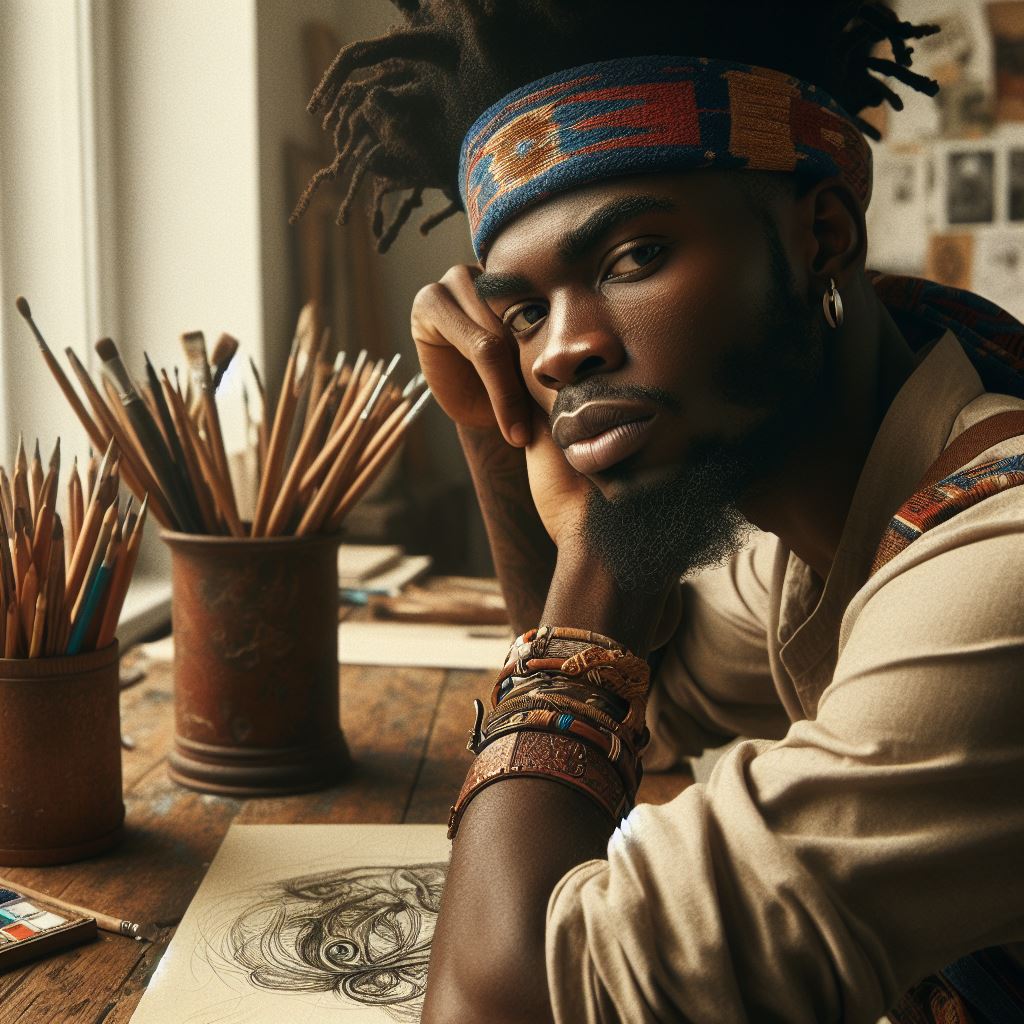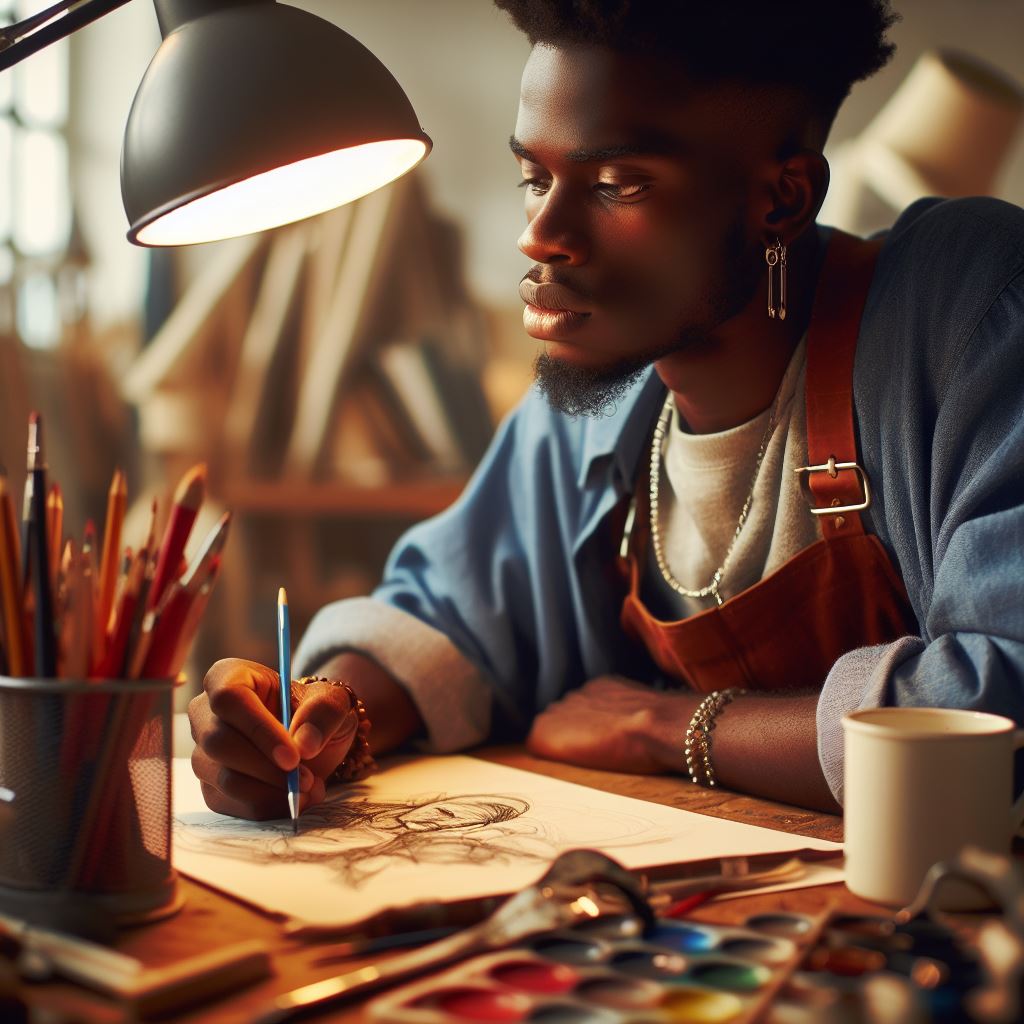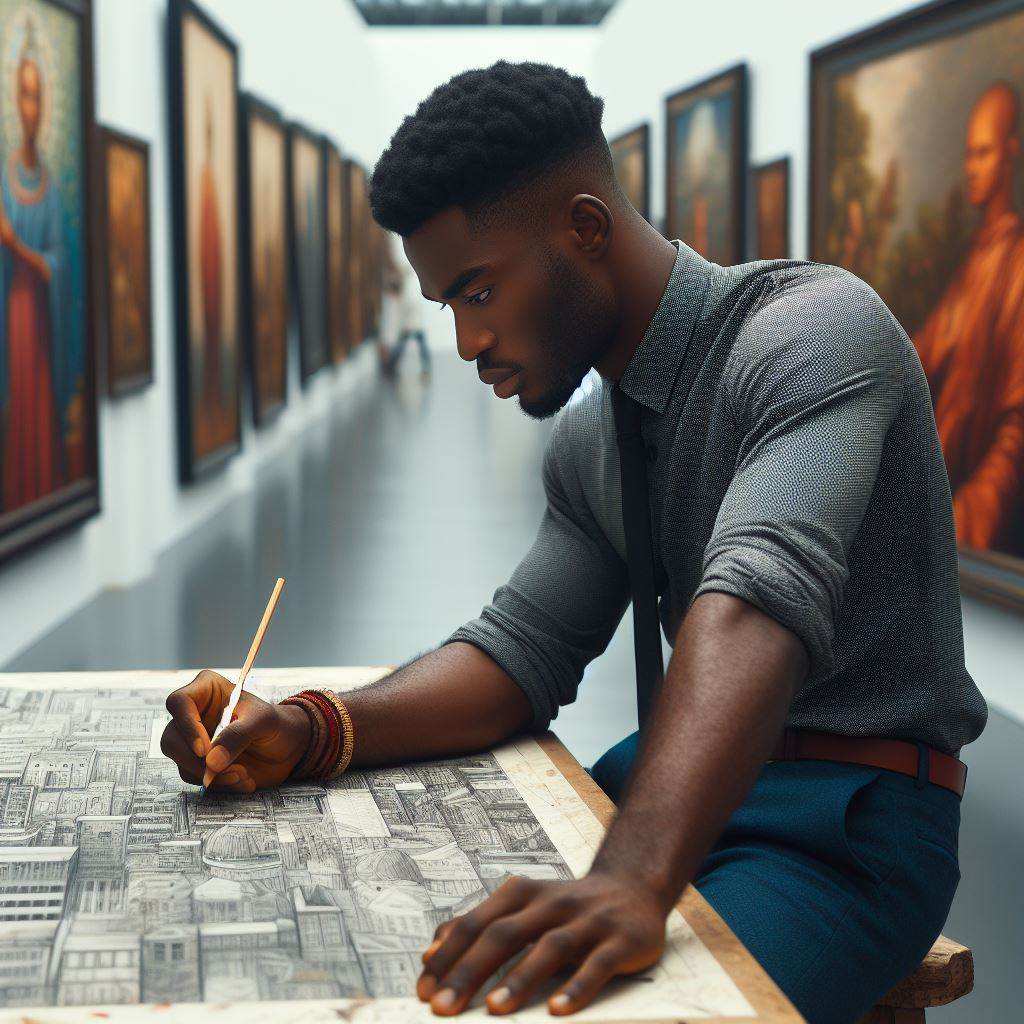Introduction
African art significantly influences global design trends with its unique styles and rich cultural heritage.
Traditional crafts and contemporary art from Africa gain global recognition. They shape designers’ and consumers’ aesthetic preferences worldwide.
African art’s importance in global design trends stems from its ability to introduce diverse patterns, colors, and motifs, refreshing the design industry.
Designers infuse their work with authenticity and cultural richness by incorporating elements of African art, resonating with a global audience.
African art impacts global design trends by inspiring creativity, promoting cultural exchange, and challenging conventional beauty and aesthetics.
The Impact of African Art on Global Design Trends
Brief Overview of the Topic
African art has captivated audiences worldwide for centuries. Its rich history and diverse styles reflect the continent’s vibrant cultures.
From ancient sculptures to contemporary paintings, African art showcases creativity and storytelling. This unique art form has significantly influenced global design trends, leaving a lasting impact on fashion, architecture, and interior design.
Importance of African Art in Global Design Trends
African art has significantly shaped global design trends in numerous ways. Its influence extends beyond aesthetics, embodying cultural significance and heritage. Here are key aspects of its importance:
- Cultural Richness: African art reflects a deep cultural heritage, celebrating diverse traditions and histories.
- Innovative Aesthetics: The use of bold colors, abstract forms, and intricate patterns offers fresh perspectives in design.
- Sustainable Practices: African art often incorporates sustainable materials and techniques, promoting eco-friendly design.
- Symbolism and Meaning: Artworks often carry profound meanings and stories, enriching the design with depth and narrative.
Thesis Statement on the Impact of African Art
African art has profoundly influenced global design trends by introducing unique aesthetics, promoting sustainability, and enriching cultural narratives.
The Unique Aesthetics of African Art
African art’s unique aesthetics have revolutionized global design. Designers worldwide draw inspiration from its bold colors and abstract forms. African textiles, for instance, feature vibrant patterns and intricate designs, adding a dynamic flair to fashion and home décor.
- Bold Colors: Bright and contrasting colors create visually striking pieces.
- Abstract Forms: Non-representational shapes challenge conventional design norms.
- Intricate Patterns: Detailed motifs and patterns enhance visual interest.
Promoting Sustainability through African Art
Sustainability is a cornerstone of many African art practices. Artisans often use recycled materials and traditional crafting techniques. This approach not only reduces waste but also preserves cultural heritage. Global designers have adopted these practices, promoting eco-friendly and ethical design.
- Recycled Materials: Using discarded items to create new art reduces environmental impact.
- Traditional Techniques: Handcrafting methods ensure durability and authenticity.
- Eco-Friendly Designs: Sustainable art inspires greener design solutions globally.
Enriching Cultural Narratives in Design
African art is steeped in cultural narratives and symbolism. Each piece tells a story, connecting the past with the present. This storytelling aspect enriches global design, offering depth and meaning to otherwise purely aesthetic elements. Designers incorporate African symbols and motifs to create pieces with cultural resonance.
- Storytelling: Artworks narrate historical and contemporary tales.
- Symbolism: Symbols convey deeper meanings and values.
- Cultural Resonance: Designs rooted in tradition resonate globally.
African art’s impact on global design trends is undeniable. Its unique aesthetics, sustainable practices, and rich cultural narratives continue to inspire designers worldwide.
By embracing African art, the global design community celebrates diversity, innovation, and sustainability.
Historical significance of African art
Exploration of traditional African art forms
African art has a rich history dating back thousands of years. It has served as a means of communication, cultural expression, and spiritual representation for various African societies.
Traditional African art forms encompass a wide range of mediums, including sculpture, masks, textiles, pottery, and jewelry. Each of these forms has specific cultural significance and symbolism attached to them.
Influence of African aesthetics on global designs
Bold colors, geometric patterns, and intricate designs characterize African art, exerting a significant influence on global design trends.
Many designers and artists have drawn inspiration from African motifs and styles.
Examples of African art that has made an impact on global design trends
One prime example of African art making an impact on global design trends is the use of kente cloth patterns in fashion and interior design.
The vibrant colors and unique geometric designs of kente cloth have become synonymous with African aesthetics.
Modern jewelry and accessories incorporate African tribal motifs, adding a unique touch inspired by traditional art forms.
African art’s influence extends to contemporary art and sculpture, evident in its vibrant motifs and innovative techniques.
El Anatsui, renowned for his large-scale metal sculptures crafted from discarded materials, draws inspiration from traditional African art.
In summary, African art’s historical significance, exploration of traditional forms, and influence on global design highlight its enduring impact.
Read: Research Areas in African and Asian Studies
Contemporary African artists and designers
Several talented individuals in contemporary African art and design make a significant impact on global design trends.
These artists and designers seamlessly blend traditional African elements with modern aesthetics, creating unique and innovative pieces that resonate with audiences worldwide.
Profiles of influential African artists and designers
El Anatsui, a Ghanaian sculptor, is renowned for creating large-scale installations from discarded materials like bottle caps and metal scraps.
His work blurs the line between sculpture and textile, drawing inspiration from traditional African weaving techniques.
Malian photographer Malick Sidibé, renowned in the African art scene, captures the essence of post-independence African youth culture with his black-and-white images.
His portraits have been exhibited in galleries and museums around the world, showcasing the vibrancy and energy of African society.
Their contributions to global design trends
Within the African art community, these artists and designers gain recognition and significantly impact global design trends.
Their innovative use of materials, colors, and textures has inspired designers from all corners of the world to incorporate African elements into their own work.
For instance, traditional African textiles’ bold patterns and vibrant colors are now popular motifs in fashion and interior design.
African artists like textile designer Yinka Shonibare and fashion designer Duro Olowu have played a key role in bringing these elements to the forefront of the international design scene.
How they integrate African elements into modern designs
One of the key ways in which these artists and designers integrate African elements into modern designs is through a fusion of traditional craftsmanship and contemporary techniques.
They combine age-old practices with cutting-edge technologies, creating culturally rich and visually stunning pieces..
Through sculpture, photography, fashion, and interior design, these artists redefine African identity on a global scale.
Their work serves as a bridge between past and present, tradition and innovation, helping to shape the future of design in an increasingly interconnected world.
Indeed, contemporary African artists and designers make significant contributions to global design trends. Their impact cannot be understated.
By drawing inspiration from their rich cultural heritage and combining it with a modern sensibility.
They create beautiful and impactful artwork, while also challenging traditional boundaries of art and design.
Read: Day in the Life of a Nigerian Beauty Therapist
Use of African motifs and patterns in design
One of the key elements of African art that has made a significant impact on global design trends is the use of motifs and patterns.
African heritage and traditions deeply root cultural symbols and designs, rendering them visually stunning and historically rich.
Common motifs and patterns in African art
African art is known for its use of geometric shapes, abstract forms, and vibrant colors. Some common motifs include tribal markings, masks, animals, and symbols representing important life events or concepts.
In African art, intricate designs prevail, crafted through repetitive shapes or symbols, forming patterns. These patterns can be found in textiles, pottery, jewelry, and even architecture.
How these motifs are being incorporated into contemporary design
Designers and artists around the world have been inspired by African motifs and patterns, incorporating them into contemporary design in innovative ways.
These traditional elements bring a sense of authenticity and cultural richness to modern spaces and products.
From fashion to interior design, African motifs are being used to add a unique and dynamic touch to various creative projects.
Bold patterns on rugs or subtle motifs on furniture pieces establish a connection to African culture.
Examples of products or spaces that feature African-inspired motifs
- Fashion: Many fashion designers have drawn inspiration from African motifs, using them in clothing and accessories to create eye-catching designs.
- Home decor: African-inspired patterns can be seen in home decor items like throw pillows, blankets, and wall art, adding a touch of global flair to any space.
- Art installations: Contemporary artists often incorporate African motifs into their installations, creating immersive and culturally resonant experiences for viewers.
- Restaurants, hotels, and retail stores are incorporating African-inspired motifs into their interior designs, captivating customers effectively.
In review, the use of African motifs and patterns in design has become a powerful trend that continues to captivate and inspire designers worldwide.
Creatives celebrate African culture by incorporating its elements into their work. They create unique designs that resonate globally.
Read: Innovations in Language Arts Teaching Methods

Global appreciation for African art
Rise in popularity of African-inspired design
Many people around the world are increasingly recognizing and celebrating the beauty and cultural significance of African art.
From traditional masks and sculptures to contemporary paintings and textiles, African art has captivated the global audience with its unique aesthetics and rich history.
Recently, African-inspired design has surged in popularity across industries like fashion, interior décor, and graphic design.
Designers and artists draw inspiration from African motifs, patterns, and color palettes. They create modern and innovative products.
Impact of social media and globalization on the visibility of African art
Social media and globalization play a crucial role in enhancing the visibility of African art globally.
Instagram, Pinterest, and Facebook allow African artists to showcase their work to a worldwide audience.
They gain recognition and appreciation beyond local communities.
Collaborations between African artists and international brands
Moreover, globalization facilitates increased connectivity and cultural exchange, fostering collaborations between African artists and international brands.
These partnerships expose African art to new markets, enabling artists to expand their reach and influence globally.
Transform Your Career with Expert Guidance
Get personalized mentorship consulting that’s tailored to your unique path. Our expert advice is actionable and exclusive.
Get StartedRead: Communication Arts and Social Media Influence
Challenges and opportunities for African artists
Being an African artist comes with its own set of challenges, including
- Lack of recognition in the global art and design industry.
- Difficulty in accessing funding and resources for projects.
- Limited opportunities for exposure and growth outside of Africa.
- Struggling to overcome stereotypes and biases about African art.
However, despite these challenges, there are numerous opportunities for African artists to thrive and succeed
- Increased interest and demand for diverse cultural perspectives in art and design.
- Platforms like social media and online galleries provide global exposure.
- Collaborations with international artists and designers for mutual benefit.
- Emerging markets that value authentic and unique cultural expressions.
Efforts to promote African art and design on a larger scale
Recognizing the talent and cultural richness of African artists, various initiatives have been put in place to promote their work on a global scale:
- International art exhibitions and fairs showcasing African art and design.
- Partnerships with influential galleries, museums, and institutions to curate African art collections.
- Support programs that offer mentorship, training, and resources for African artists.
- Advocacy for fair trade practices and ethical partnerships in the art industry.
By leveraging these opportunities and initiatives, African artists can overcome challenges, gain recognition, and contribute to the vibrant global design landscape.
Conclusion
Recap of African Art’s Impact
African art significantly influences global design trends like its bold patterns, vibrant colors, and unique textures inspire designers worldwide.
This influence can be seen in fashion, interior design, and visual arts. Designers incorporate African motifs, creating stunning, culturally rich pieces.
Call to Action
Let’s support and celebrate African artists and designers and here are some ways to do so
- Purchase African Art: Buy art directly from African artists to support their work.
- Promote African Designers: Share their work on social media and through word of mouth.
- Attend Exhibitions: Visit galleries and exhibitions showcasing African art.
- Collaborate: Encourage collaborations between African and international designers.
Final Thoughts
African art has a bright future in the global design industry. Its rich heritage and creativity will continue to inspire. As we celebrate and support African artists, we enrich the global design landscape.
Let’s embrace the beauty and diversity of African art, ensuring it remains a vital influence in design. The future looks promising for African art, with endless possibilities for growth and innovation.




